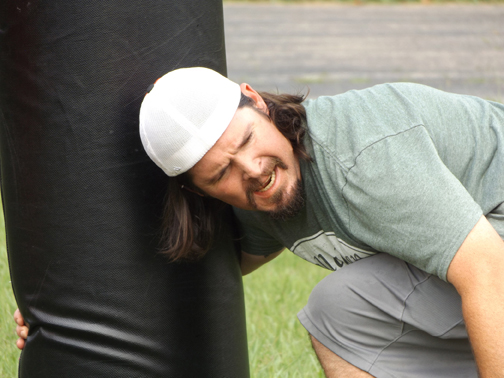Football is a very popular sport that most everyone enjoys to watch or even play. Research has shown that football poses some dangers to kids who decide to play the game when they are young. Although most football programs for kids now include safety training, many still wonder if football is a safe sport for children.
According to news and data website FiveThirtyEight, researchers have shown that head hits in youth sports increase the risk of developing chronic traumatic encephalopathy, or CTE, later in life. CTE is an untreatable, degenerative brain disease with symptoms like memory loss and dementia.
Marty Moore is Sevier’s athletic director. Part of his job includes making sure that coaches and students follow safety guidelines.
“The potential for catastrophic head and neck injuries are by far the most dangerous parts of football in my opinion and are the ones we hear the most about,” Moore said.
Boston University’s Chronic Traumatic Encephalopathy Center has published three studies about youth football. The studies agree that adults who played tackle football as children were more likely to deal with emotional and brain challenges later in life.
This year, injuries on Sevier’s football team were generally mild in comparison.
“The only injury I saw is that one person tore his ACL,” Darius Hoffer-Christian, one of this year’s football players, said.
Those types of injuries tend to be more common among young football players.
“The long lasting effects of leg injuries, especially to the knees and ankles, are injuries that more people end up dealing with just because most people have these types of injuries at some point in their football careers,” Moore said.
Since the effects of brain injuries can be so severe, safety measures have to be put in place for students who play football.
“There are several techniques that are taught now that we’re not once taught, especially about tackling, to reduce the number of head and neck injuries,” Moore said. “Also, penalties have been put in place to protect players in those same vulnerable areas to discourage hits on those areas, especially when a player is defenseless.”
Football coach Isaiah Spivey agreed.
“We want the brunt of the force to be taken on the shoulder pads; that’s where the pads are the thickest,” he said. “Football pads are designed to keep players safe. We’re not ever going to take the head out of the game. Most important is that when there is contact to the head, the face is up and we don’t get that compression of the spine. So, we teach students to keep their heads up.”
Since the sports can be extremely dangerous, schools that have a football team have to take a lot of precautions to keep their players safe. Research again and again has shown that repeated blows to the head can have long-term effects.
“I am not surprised about the findings of repeated blows to the head and the long lasting effects on a person’s health and well-being,” Moore said. “I believe the discovery of CTE and concussion safety that has been implemented over the last several years has drastically helped reduce these problems, but they are always going to be present.”
One thing for certain is that helmets are a crucial part of keeping the players safe. Most football programs reuse helmets from year to year.
“They do have a shelf life of 10 years max, but have to be recertified and refurbished every other year by an outside group,” Moore said. “In our case, we buy Riddell helmets, so their representative comes to our school, inspects the helmets, throws away the ones that we cannot use, and takes the ones needing refurbishing back to their company before sending them back to us. Refurbishing includes new padding inside the helmet, possibly a new facemask, or anything that can be replaced without destroying the integrity of the helmet.”
Spivey is grateful for this process.
“We definitely don’t want to have anybody in a helmet that is not certified,” he said. “A lot of the helmet technology is getting a lot better. So, we are making the game safer. I know when I played, helmet technology wasn’t that great. You know, sure, we did have padding in our helmets, but the padding was not as sophisticated.”
In addition to helmets and new tackling strategies, coaches also rely on yearly training.
“We are trained in the signs and symptoms of concussions and also cardiac arrest and heat stroke,” Spivey said. “We go through training every year. So, it’s a lot of the same training but it refreshes you right before the season.”
People have proposed changing the rules to make football safer, such as playing football in schools as a no-tackle sport. Some football players think that this is not a good idea.
“The whole point of football is hitting people without getting in trouble,” Hoffer-Christian said. “They’re a whole bunch of complainers.”
Spivey, too, is unsure if removing tackling would be a good change for the game.
“To me, if you take away the contact, if you take away the tackling, it’s not football,” he said. “Football consists of blocking and tackling. It’s a game that teaches toughness. It’s a game that teaches resilience and teamwork and, and just a lot of life lessons. So, if you take that away, I’m not sure that I would call it football.”
Despite the risks, football remains incredibly popular, even in middle school.
“I am a huge fan of football, enjoyed playing it growing up, and I think football can be played safely,” Moore said. “However, with all contact sports or sports involving moving parts or people, there are some inherent risks involved. Whether it be baseball, basketball, or football, or any other sport, you have the risk of being injured in all of them in various ways.”
Spivey agreed.
“You know, it’s a great game and it can be dangerous at times, but we take care of our body, we prepare our body,” he said. “Focusing on the safest ways to play is how we keep this great game going.”
This story was originally published on The Sequoyah Scribe on May 13, 2022.







































